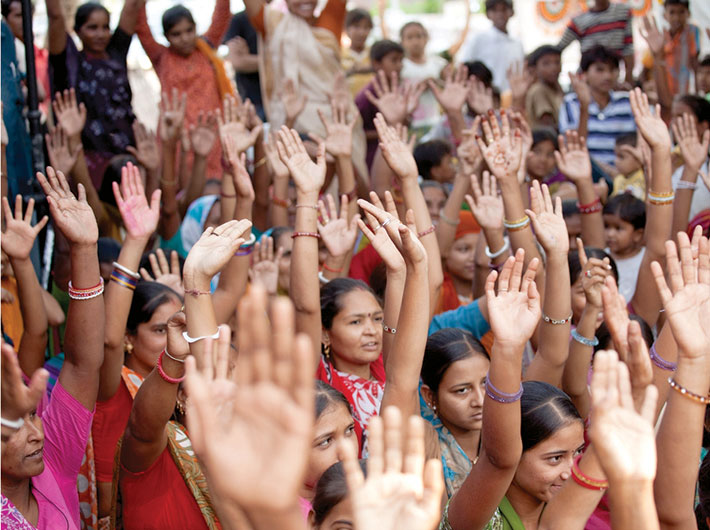Joining hands with small producers and service providers in informal sector makes sense for big corporates
The new Companies Act 2013 recognises that companies emerge from the rich diversity and economic culture within India. CSR acknowledges the need for companies to contribute back to the societies they come from.
One of the best ways to contribute is to strengthen this rich economic culture that is the culture of self-employment. Unlike many developed and developing countries, over 50 percent of India’s work-force is self-employed, and most of the enterprises are unincorporated, small and in the informal economy. The non-agricultural sector alone has over 5.7 crore such enterprises.
Some of the self-employed at the tip of the iceberg are real entrepreneurs, ready to take risks, likely to grow and perhaps even become a company one day. But most of them are “survivalists”, their risks are thrust upon them.
As we see from the “pyramid” above, a few entrepreneurs do well and are at the peak of the pyramid. Women tend to be at the bottom of the pyramid, generally working within their homes or in their own farms, often as unpaid family workers.
Economic diversity and an interdependent economy
The universe of the informal economy – the small farmers, street vendors, tailors, domestic workers, and many more – is part of the interconnected economic culture, reaching from the smallest self-employed farmer in the village to the largest retail company. The food products sold by large companies start off as grain or pulses or fruit or vegetable grown by small and marginal farmers. Workers in small towns near Lucknow and Bareilly embroider or zari garments for clothing retail majors worldwide. Families in remote villages use soaps made by FMCG companies; the CEOs of the same companies employ domestic workers living in slums near their houses.
India is one of the few countries which retain both cultural and economic diversity. The handicrafts traditions survive and adapt to new markets even as Indian companies compete in the world market for western clothing. Passengers using metro trains constructed with the latest technology rely on cycle rickshaws to take them home from the stations. Shoppers come out of malls and buy their vegetables from street vendors. Clothes purchased in retail chains are altered by the tailor on the pavement. The price of a meal can vary from '5,000 at a restaurant to '50 at the local dhaba. This large diversity needs to be recognised and preserved.
Economic structures in India can be divided into the private/corporate sector, public sector and the informal sector. The small enterprises, the own account workers, the small farmers earlier mentioned, etc. all belong to the informal sector, the largest sector of the economy. At present the private and public sectors dominate the economy in terms of control and visibility. Prices and markets are generally controlled by these sectors, as are the laws and policies. As more and more enterprises previously controlled by the public sector are privatised, the size of the public sector is shrinking.
The people’s sector
Due to the extremely small size of informal enterprises, work in the ‘people’s sector’ is uncertain and of high risk, with low productivity and low earnings and income. A few energetic and entrepreneurial individuals are able to escape and become bigger in size, but the majority are trapped in the informal sector. In general the only way for them to come together is through pooling their resources and forming a joint enterprise.
These larger work systems, which may or may not be officially registered, may be cooperatives, which predominate in India in the milk sector, handloom sector and agricultural sector; or they may be unregistered groups such as the chit funds, farmer’s irrigation groups, or groups of producers supported by non-government organisations. There are literally millions of such groups across the country, which are the basis of the production systems, yet they remain undocumented and unrecognised. We call this vast system of small producers/vendors/service providers with its network of formal and informal organisations the ‘people’s sector’.
The organisations of the people’s sector act as pooling devices which enable scaling up for very small producers with tiny resources. A milk co-operative, for example, allows producers to sell small amounts of milk at standard prices, and it becomes cost-effective to process the pooled milk, especially when the product from a number of co-operatives is combined. A self-help group (SHG) enables women to pool tiny amounts of money as small as '50 per month, which can be collected and lent out at reasonable interest rates. An incense-stick (agarbatti) manufacturing producer company can take large orders form a retail company, which could not deal with each individual producer. These types of economic organisations can be managed well by the small producers as long as they remain small. However, when these enterprises are successful they need to grow and require a higher level of management.
Self Employed Women’s Association (SEWA) has been organising women in the informal economy for over forty years. Started as a trade union for rights of the workers, its founder, Elaben Bhatt, soon realised that informal workers and producers needed a developmental approach. Responding to their need for credit, the SEWA co-operative bank was registered which today has over four lakh depositors with a capital of over 250 crore. The formation of the bank was followed by a co-operative of Muslim women who sewed quilt covers, and then by co-operatives of bamboo producers, block printers and weavers. Today SEWA has sponsored over a hundred co-operatives, a number of producer companies and federations of SHGs and different types of micro-finance institutions.
Supporting the people’s sector: A win-win situation for companies
Based on this experience, a number of issues emerge which need to be dealt with in order to make the people’s sector organisations successful. The small SHGs, unregistered groups, etc. that are spontaneously formed by the small producers or workers need to be scaled up to become effective. Generally, this requires outside intervention from an NGO or the government or any other external agency, which is able to support these small groups. This is an area where CSR can be extremely useful, particularly as the support required is not merely financial but can feed into the expertise developed within the corporate itself. Further, the corporate can also generate business for these small organisations thereby creating a win-win situation. However, unless these organisations are oriented in the right way they may not become successful.
First: the organisation has to run as an economic organisation rather than an NGO. Many such economic enterprises are sponsored by NGOs with charitable funds, but the producers themselves are seen as “beneficiaries” rather than economic actors, and the organisation remains dependent on these charitable funds to continue to function. It has to be understood that economic organisations require a business orientation and financial sustainability.
Second: if the enterprise is to be sustainable, the producers or members have to be the decision-makers, that is, they have to be on board, they not only benefit but are also the owners of the enterprise. The small producers or workers, usually find it difficult to think of themselves as the owner of this enterprise, and hence responsible for decisions. Changing the mindset from “worker” to “owner” is a major task.
Third: sustainability requires a balance between income to the producer/owners and profits to the enterprise. For example, the board of SEWA Bank consists of poor self-employed women. They have to decide the interest rates on loans to members. They have to understand that a higher interest rate means a burden on the loanee, whereas a lower interest rate may lead to reducing profitability of the bank, so the decision they take on interest rates is a balancing of these two functions. This is always only looking to increase her own meagre income.
Fourth: dealing with larger markets is often difficult for small producers who have only dealt with small contractors. Approaching a big company, talking to their managers and striking a deal becomes impossible for them. Not only do the poor producers lack confidence, but the managers of the big companies, who consider them uneducated and of a lower class, will not deal with them.
Fifth: any enterprise requires hiring of professionals who may be accountants, managers, designers etc. The relations between the producers who control the board and for whom the enterprise is set up, and the professionals who are experts, is often strained. Rather than a partnership, the professionals quite easily take over the decision-making, which leads to tensions and ultimately may not benefit the enterprise.
Sixth: regulators and government agencies require considerable attention. Often the rules and regulations governing these enterprises are burdensome, and difficult to deal with. Corruption also exists in some departments and causes major difficulties in the functioning of the enterprise. The Co-operative Act in most states is so cumbersome that co-operatives either become one-person enterprises or just close down. The enterprise needs mechanisms to deal with the government departments.
Finally, a major threat to these enterprises is the danger from within. It is quite common for a more “entrepreneurial” member of the group to take over its functioning and reduce others to mere workers. Even more common is cheating internally where all resources of the enterprise are siphoned off by those in charge. This can only be prevented with strong systems and methods for holding people accountable for funds and performance.
The people’s sector can be an important target for CSR. Perhaps the best strategy would be for companies to work with NGOs and other agencies who have already shown a certain amount of effectiveness and capacity. The need of the hour is to multiply and scale up successful strategies leading to higher productivity, incomes and happiness in the vast bulk of the country’s poor self-employed.
(This article appeared as part of a CSR special package in May 16-31, 2014 print issue)

